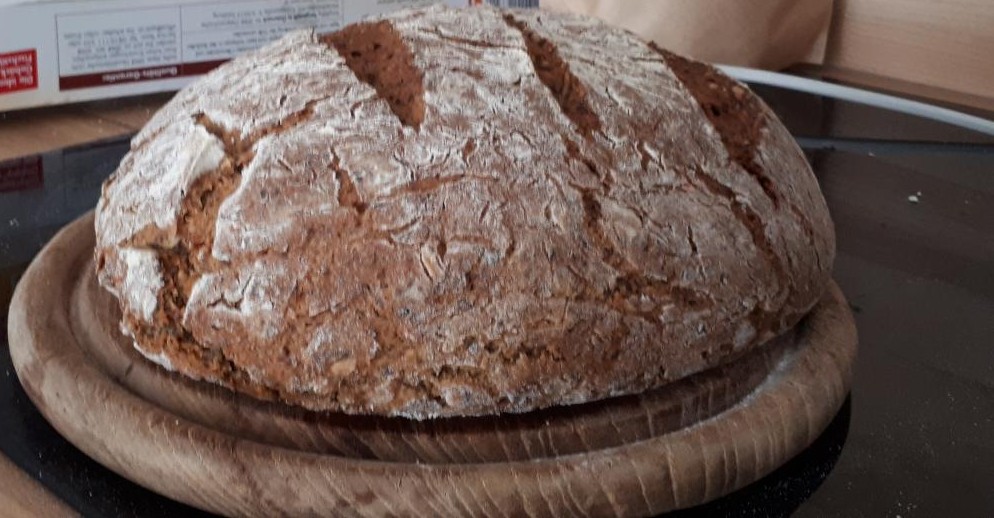My favourite culinary species outside of chanterelles and morels. They have a much richer meat flavour than an oyster mushroom, very close in taste and texture to beef pot roast. They typically associate with conifers in wet high elevation (2000m~) forests, fruiting from now until Septemberish. These and Boletus edulis make good novice foraging targets because they’re easy to identify and the lookalikes are distinct.
I cut it into strips after soaking it to remove bugs and stripping the outer flesh, then sauteed them in olive oil with pepper/salt/garlic powder. It’s the only specimen I found today and weighed about 1kg.
I like patting boletes like a little dog
God I wish I was confident to forage mushrooms without poisoning myself, so cool!
Depending on what you have near you, there are a few safe species that are as good as they are easy to distinguish:
Pleurotus sp. - Oysters, growing on trees or deadwood. Very distinct shape.
Cantharellus sp. - Chanterelles, growing on the forest floor in open spaces. Very distinct shape and colour.
Hericium sp. - Lion’s mane, growing on trees or deadwood. Very distinct shape.
Morchella sp. - Morels, growing on the ground. They have closer lookalikes than the above genera but can still be distinguished pretty easily from those and look like nothing else.
Boletus edulis - The trickiest of this list, growing on the ground next to spruce/fir/pine trees. The genus is super easy to distinguish but identifying the species within that requires cutting it open.
I’d never pick anything generic-looking like a little brown/white mushroom. Those are where you really risk being poisoned. With these you’d want a field guide to positively ID them but you get good at that fast. There’s probably a mycology club in your area which organises regular foraging trips with experts and I highly recommend doing those. The Colorado Mycological Society is a huge resource here.
Fwiw, mycology has had a pretty big boost in popularity/notoriety here (take your pick) due to a high profile murder case outside of Melbourne which just concluded today, in which a woman was found guilty of three cases of murder and one of attempted murder, by poisoning a beef Wellington with death cap mushrooms she foraged herself.
Her case is why the only white mushroom I’ll pick is a Hericium species. Death caps look so close to young puffballs that it would be an easy mistake to make unintentionally. If it’s brown or white it needs to have a very distinct morphology for me to feel comfortable even IDing it.
How do you prepare a lion’s mane if you pick one? I’ve only ever seen it as a health supplement
Lion’s mane is delicious. It’s mainly used as a lobster/crab cake substitute because it has a similar consistency and taste. Just soak it to remove nesting bugs and slice off any dirty parts. Then cut it into thin slices and put them in a dry pan over medium heat. You need to cook the water out so they soak up oil, so I cook them on their own for 3-5 minutes. When they’ve shrunk but not burned, I use olive oil/sea salt/black pepper/garlic/onion and cook them for another 5~ minutes until browned. They pair great with white sauce pasta, rice, stir fry, and tofu dishes.
I wish I had deciduous forests around here for them. They’re probably the easiest to spot and ID of all of those.
Thank you! This whole thread has been an education. I won’t find them growing anywhere near me unfortunately but home cultivation seems doable
You can cultivate lions mane with totem method, I have done it successfully
It’s probably the cheapest and easiest species to grow. I drill holes in 5 gallon buckets stuffed with hydrated and pasteurised straw. The colonies can be grown from liquid cultures on grain or just recycled from the inner mycelium on a store-bought/foraged specimen. As long as the area is semi-shaded and kept humid, they’re so productive.
If you get a proper field guide, pick an easy species to identify, learn what specific characteristics to look for, and what specific look-alikes to avoid & how differentiate them. Step by step It’s pretty straightforward.
-A lot of people start with Morels because they are easy to identify and their look-alikes aren’t all that similar. Plus, (when cooked) they are delicious.







